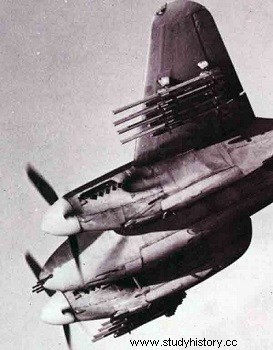
As we will see elsewhere, the use of rockets made immense progress during the war; in anti-submarine warfare, they were used in two other very interesting ways. One was the so-called “harpoon” rocket, a simple 76 mm solid-propellant rocket engine, with a full warhead weighing 11 kg at the front, capable of piercing armor. Despite its primitive side, it gave all satisfaction, because only one thing was expected of it:to make a hole in the hull of the submarine to prevent it from diving; Forced to stay on the surface, it could then be attacked with conventional means.
Under the official name of "76 mm Aircraft Rocket Model I", this machine was delivered to the English naval aeronautics, and used successfully in May 1943 from the first combat. A Swordfish aircraft from the aircraft carrier Archer, piloted by Ensign Horrocks, surprised U-752 on the surface. It fired a salvo of eight rockets, one of which pierced the hull; whereupon a Wildcat aircraft, which was accompanying the Swordfish, fired machine guns at the immobilized U-boat. The crew then opened the floodgates and abandoned the submarine.
The other use of rockets was quite unusual. Planes equipped with MAD were beginning to enter service and we found ourselves. faced the following problem:how could they act effectively when they had located a submarine while diving? The magnetic detector signaled this when the plane passed overhead, but too late to launch a conventional bomb or grenade, the normal trajectory of which would hit the water well ahead of the plane's position. when spotting the target. For the same reason, impossible to use rockets or machine guns. After studying the question, the California Institute of Technology found the answer:a 16 kg "Retro-Bomb". that is to say, a bomb with an ordinary high explosive, equipped with a contact fuse and a small rocket motor at the front. The power of this engine was calculated exactly to give the bomb a speed equal to that of the plane, but in the opposite direction; the burning time of the engine was also carefully calculated. As a result, when the MAD aircraft had detected a submarine, the operator pressed a button that ignited the retro-bomb's rocket engine; it separated from the plane, animated by a relative speed contrary to its own, which caused the bomb to fall vertically on the submarine. After the rocket motor was turned off, the bomb continued to fall vertically. In order to increase the chances of achieving the goal. an automatic circuit fired three salvos at timed intervals to give them such a dispersion that the bombs arrived in the water in three rows 30 m long, each separated by 27 m thus completely covering the average length of an average submarine with a density that ensures an almost certain hit.
Aircraft equipped with MAD were not used in all seas because, for various technical reasons related to the detection system, only certain geographical regions were suitable. As luck would have it, one of these regions, perfectly adapted to their use, was the Strait of Gibraltar; a formation of Catalina aircraft, colloquially known as “MAD-Cats”*, patrolled there in 1944 and effectively interdicted U-boat passage into the Mediterranean.
